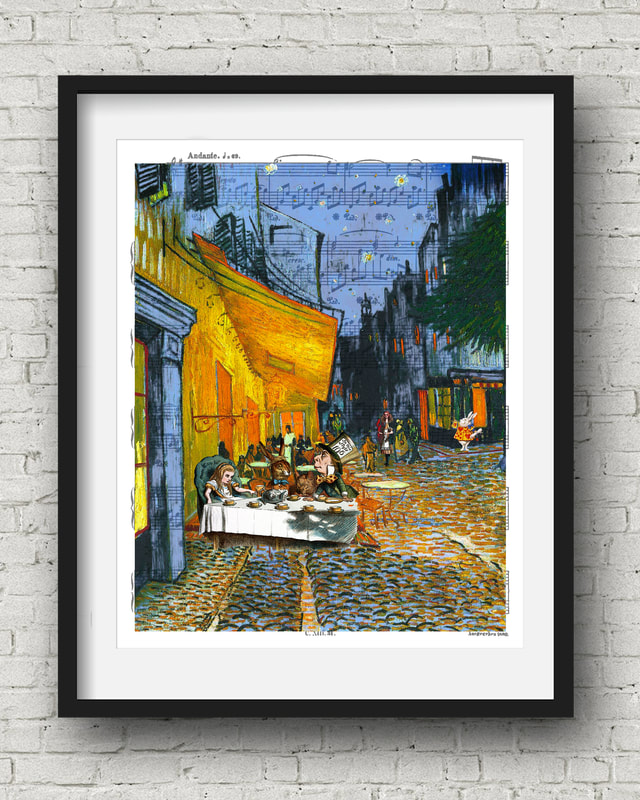A Wonderland Tea Party in Vincent Van Gogh's Café Terrace at Night
Featuring the Mad Hatter, the White Rabbit, the Dormouse, the March Hare, and, of course, Alice.
Overlaid on Sheet Music Artwork
This print is part of the Alice in Wonderland and Van Gogh Art Collections
Inspire your home space with this beautiful and unique illustration combining Vincent Van Gogh's Café Terrace with John Tenniel's and Arthur Rackham's Wonderland illustrations and a unique sheet music art background. This print will look great in your living room, office, den, library, or bedroom. Printed in California on luxurious, gallery quality paper for fine art.
About Café Terrace at Night
Café Terrace at Night, also known as The Café Terrace on the Place du Forum, is an oil painting executed by the Dutch artist Vincent van Gogh while at Arles, France, in mid-September 1888. The painting is not signed, but described and mentioned by the artist in three letters.
Visitors to the site can still stand at the northeastern corner of the Place du Forum, where the artist set up his easel. He looked south towards the artificially lit terrace of the popular coffee house, as well as into the enforced darkness of the rue du Palais leading up to the building structure (to the left, not pictured) and, beyond this structure, the tower of a former church (now Musée Lapidaire). Towards the right, Van Gogh indicated a lighted shop as well, and some branches of the trees surrounding the place—but he omitted the remainders of the Roman monuments just beside this little shop.
The painting is currently at the Kröller-Müller Museum in Otterlo, Netherlands.
About the Mad Hatter
In Alice in Wonderland
The Hatter character, alongside all the other fictional beings, first appears in Lewis Carroll's 1865 novel Alice's Adventures in Wonderland. In it, the Hatter explains to Alice that he and the March Hare are always having tea because when he tried to sing for the foul-tempered Queen of Hearts, she sentenced him to death for "murdering the time", but he escapes decapitation. In retaliation, time (referred to as a "he" in the novel) halts himself in respect to the Hatter, keeping him and the March Hare stuck at 18:00 (or 6:00 pm) forever.
When Alice arrives at the tea party, the Hatter is characterised by switching places on the table at any given time, making short, personal remarks, asking unanswerable riddles and reciting nonsensical poetry, all of which eventually drives Alice away. The Hatter appears again as a witness at the Knave of Hearts' trial, where the Queen appears to recognise him as the singer she sentenced to death, and the King of Hearts also cautions him not to be nervous or he will have him "executed on the spot".
In Through the Looking-Glass
The character also appears briefly in Carroll's 1871 Through the Looking-Glass, the sequel to Alice's Adventures in Wonderland, under the name "Hatta" - alongside the March Hare under the name "Haigha", which is pronounced "hare." Sir John Tenniel's illustration depicts Hatta as sipping from a teacup as he did in the original novel. Alice does not comment on whether Hatta is the Hatter of her earlier dream.














